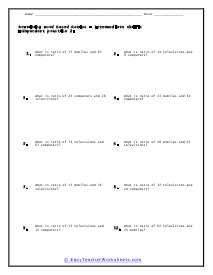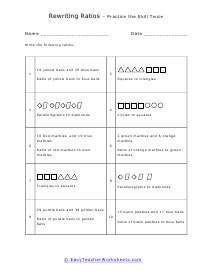A ratio is a comparison of two quantities. They can be expressed in a variety of ways. They can be word based (i.e., there are three red balls for every five blue balls); they can be expressed in a numerical form (i.e., the ratio of red balls to blue balls is 3:5); or they can be expressed as fractions (i.e., 9/15). In these worksheets, your students will review how to write ratios by referring to pictures and expressing the proportions of objects in each picture. They will then rewrite ratios by translating them from one form of expression to another (i.e., rewrite word based as numerical ratios; rewrite numericals in a word based form). Be careful while writing the same number. Whatever the number you select will always depend on the problem. For example; You will write the ratio of squares to circles in different ways like; the ratio of squares to circles = 3/6 , 3 to 6 , 3:6. We can also write the it in simple way as we compare two values to form a ratio. For example, one yellow ball and three green balls in a basket. We will compare both and write as well as read them as 1 is to 2. We can also divide two numbers as the greatest common factors. For example; we will divide both numbers 10 and 20 to obtain a ratio 1 is to 2. We can also compare numbers by using equal ratios. If you want to find the equivalence, you will need to multiply or divide the same ratio by the same number but, it shouldn't be zero. For example, divide 3:6 by 3 to get the equal ratio that is 1:2. In each case, you can divide the first number by the second one. They will be equal when quotients are equal. If you divide two equal ratios that is 3:12 by 36:72, they will be equal.
This set of worksheets contains step-by-step solutions to sample problems, both simple and more complex problems, a review, and a quiz. When finished with this set of worksheets, students will be able to write ratios in multiple forms. These worksheets explain how to write ratios, and rewrite them in word form as a numerical ratio. Sample problems are solved and practice problems are provided.


















